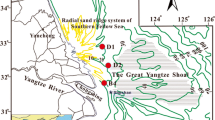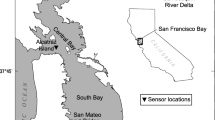Abstract
Of the factors that affect settling velocity (w s), the concentration of suspended sediments (SSC), C, and turbulence (root-mean-square velocity gradient), G, have been identified as being of major importance. This work reveals the important effect on w s of the vertical salinity gradient, s, (defined as the difference between surface and bottom salinity divided by water depth). w s was obtained by use of the Rouse equation, and ranged between 0.1 and 2.47 mm/s. w s was found to have an exponential relationship with SSC for low SSC; an inverse relationship was observed for high SSC, because of hindered settling. The study revealed that w s was inversely related to s and its effect was observed only for high values of s. A new model is proposed in which w s is explained in terms of C, G, and s. Two scenarios were considered on the basis of the stratification parameter ∂S/S 0 (the ratio of the difference between the surface and bottom salinity divided by the mean salinity): ∂S/S 0 > 0.1 and ∂S/S 0 < 0.1. The effect of s on w s was negligible when ∂S/S 0 < 0.1. Regression analysis was performed on observed w s (using the Rouse equation) and calculated w s using three approaches: (1) \(w_\text{s} \propto \,C^{x}\), (2) \(w_\text{s} \propto \,C^{x} G^{y}\), and (3) the new model \(w_\text{s} \propto \,C^{x} G^{y} s^{ - z} , {\text{for}}\) ∂S/S 0 > 0.1, and coefficients of determination of 0.59, 0.65, and 0.86 respectively were obtained. The new model has the advantage that it is dimensionally stable and the empirical coefficient is dimensionless.








Similar content being viewed by others
References
Berlamont J, Ockenden M, Toorman E, Winterwerp J (1993) The characterization of cohesive sediment properties. Coast Eng 21:105–128
Camp TR, Stein PC (1943) Velocity gradients and internal work in fluid motion. J Boston Soc Civil Eng 30:219–237
Dyer KR, Cornelisse J, Dearnaley MP, Fennessy MJ, Jones SE, Kappenberg J, McCave IN, Pejrup M, Puls W, van Leussen Wim, Wolfstein K (1996) A comparison of in situ techniques for estuarine floc settling velocity measurements. J Sea Res 36:15–29
Dyer KR, Christie MC, Manning AJ (2004) The effects of suspended sediment on turbulence within an estuarine turbidity maximum. Estuar Coast Shelf Sci 59:237–248
Edzwald JK, O’Melia CH (1975) Clay distributions in recent estuarine sediments. Clays Clay Miner 23:39–44
Einstein HA, Chien N (1955) Effects of heavy sediment concentration near the bed on velocity and sediment distribution. MRD series, no. 8, Univ. of California, Inst, of Engrg. Res. and US Army Engrg. Div., Missouri River, Corps of Engrs., Omaha, Nebr
Fathi-Moghadam M, Arman A, Emamgholizadeh S, Alikhani A (2011) Settling properties of cohesive sediments in lakes and reservoirs. J Waterw, Port, Coast Ocean Eng 137(4):204–209
Gratiot N, Manning AJ (2007) A laboratory study of dilute suspension mud floc characteristics in an oscillatory diffusive turbulent flow. J Coast Res SI 50:1142–1146
Hallermeier RJ (1981) Terminal settling velocity of commonly occurring sand grains. Sedimentology 28:859–865
Hamblin PF (1989) Observations and model of sediment transport near the turbidity maximum of the Upper Saint Lawrence estuary. J Geophys Res 94:14419–14428
Hansen DV, Rattray M (1966) New dimensions in estuary classification. Limnol Oceanogr 11:319–326
Hinze JO (1975) Turbulence, 2nd edn. McGraw-Hill, NY
Jahmlich S, Lund-Hansen LC, Leipe T (2002) Enhanced settling velocities and vertical transport of particulate matter by aggregation in the benthic boundary layer. Geografisk Tidsskrift 102:37–49
Johansen C, Larsen T (1998) Measure of settling velocity of fine sediment using a recirculated settling column. J Coast Res 14(1):132–139
Kineke GC, Sternberg RW (1989) The effect of particle settling velocity on computed suspended sediment concentration profiles. Mar Geol 90:159–174
Krone RB (1962) Flume studies of the transport of sediment in estuarial shoaling processes—final report: Uni. Lab. and Sanitary Eng. Research Lab, California (Berkeley) Hydraulic Eng, p 110
Li JF, Chen Z (1998) Sediment resuspension and implications for turbidity maximum in the Changjiang estuary. Mar Geol 148:117–124
Li Y, Wolanski E, Xie Q (1993) Coagulation and settling of suspended sediment in the Jiaojiang River estuary. China. J Coast Res 9(2):390–402
Lumborg U, Pejrup M (2005) Modelling of cohesive sediment transport in a tidal lagoon - an annual budget. Marine Geol 218:1–16
Maa JP-Y, Kwon J-I (2007) Using ADV for cohesive sediment settling velocity measurements. Estuar Coast Shelf Sci 73:351–354
Manning AJ, Dyer KR (1999) A laboratory examination of floc characteristics with regard to turbulent shearing. Mar Geol 160:147–170
Manning AJ, Bass SJ, Dyer KR (2006) Floc properties in the turbidity maximum of a mesotidal estuary during neap and spring tidal conditions. Mar Geol 235:193–211
Manning AJ, Martens C, De Mulder T, Vanlede J, Winterwerp JC, Ganderton P, Graham GW (2007) Mud floc observations in the zone of maximum turbidity of the Scheldt estuary during neap tides. J Coast Res, SI 50:832–836
Masselink G, Cointre L, Williams J, Gehrels R, Blake W (2009) Tide-driven dune migration and sediment transport on an intertidal shoal in a shallow estuary in Devon. Marine Geology, UK. doi:10.1016/j.margeo.2009.03.009
Mehta AJ (1989) On estuarine cohesive sediment suspension behavior. J Geophy Res 94(C10):14303–14314
Migniot C (1968) A study of the physical properties of various forms of very fine sediments and their behaviour under hydrodynamic actions. La Houille Blanche 7:591–620
Milligan TG, Hill PS (1998) A laboratory assessment of the relative importance of turbulence, particle composition, and concentration in limiting maximal floc size and settling behaviour. J Sea Res 39:227–241
Nezu I, Nakagawa H (1993) Turbulence in open channel flows. International Association for Hydraulic Research Monograph Series, Rotterdam
Orton PM, Kineke GC (2001) Comparing calculated and observed vertical suspended-sediment distributions from a Hudson River estuary turbidity maximum. Estuar Coast Shelf Sci 52:401–410
Owen MW (1976) Determination of the settling velocities of cohesive muds. Report no. IT 161, Hydraulic Research Station Wallingford
Pejrup M (1988) Flocculated suspended sediment in a micro-tidal environment. Sed Geol 57:249–256
Pejrup M, Mikkelsen OA (2010) Factors controlling the field settling velocity of cohesive sediment in estuaries. Estuar Coast Shelf Sci 87:177–185
Portela LI, Ramos S, Trigo-Teixeira A (2013) Effect of salinity on the settling velocity of fine sediments of a harbour basin. J Coast Res SI 65:1188–1193
Rouse H (1937) Modern conceptions of the mechanics of fluid turbulence. Trans Am Soc Civ Eng 102:463–543
Rouse H (1938) Experiments on the mechanics of sediment suspension. Proceedings of the fifth International Congress for applied mechanics, Cambridge, pp 550–554
Sanford LP, Halka JP (1993) Assessing the paradigm of mutually exclusive erosion and deposition of mud, with examples from upper Chesapeake Bay. Mar Geol 114:37–57
Schoellhamer DH (2001) Influence of salinity, bottom topography, and tides on locations of estuarine turbidity maxima in northern San Francisco Bay. In: Mehta AJ (ed) McAnally WH. Coastal and Estuarine Fine Sediment Transport Processes, Elsevier Science B V, pp 343–357
Shi JZ (2010) Tidal resuspension and transport processes of fine sediment within the river plume in the partially-mixed Changjiang river estuary, China: a personal perspective. Geomorphology 121:133–151
Shi Z, Zhou HJ (2004) Controls on the effective settling velocities of mud flocs in the Changjiang estuary, China. Hydrol Process 18:2877–2892
Shi Z, Zhou HJ, Eittreim SL, Winterwerp JC (2003) Settling velocities of fine suspended particles in the Changjiang estuary, China. J Asian Earth Sci 22:245–251
Spearman JR, Roberts W (2002) Comparison of flocculation models for applied sediment transport modeling. In: Winterwerp JC, Kranenburg C (eds) Fine sediment dynamics in the maine environment. Elsevier, Amsterdam, pp 277–293
Sternberg RW, Cacchione DA, Drake DE, Kranck K (1986) Suspended sediment transport in an estuarine tidal channel within San Francisco Bay, California. Mar Geol 71:237–258
Thorn M (1982) Physical processes of siltation in tidal channels. Hydraulic modelling in maritime engineering: Proceedings of the conference organized by the Institution of Civil Engineers, London, October 1981, Thomas Telford Ltd., London, 65–73
Thorn MFC, Parsons JG (1980) Erosion and cohesive sediments in estuaries: an engineering guide. Proceedings of the Third International Symposium on Dredging Technology, Bordeaux, pp 349–358
Uncles RJ, Stephens JA, Law DJ (2006) Turbidity maximum in the macrotidal, highly turbid Humber estuary, UK: fluid mud, stationary suspensions and tidal bores. Estuar Coast Shelf Sci 67:30–52
van der Lee WTB (1998) The impact of fluid shear and the suspended sediment concentration on the mud floc size variation in the Dollard estuary, The Netherlands. In: Black KS, Paterson DM, Cramp A (eds) Sedimentary processes in the Intertidal Zone, geological society, vol 139. Special Publications, London, pp 187–198
van Leussen Wim (1994) Estuarine macroflocs and their role in fine grained sediment transport. Dissertation. University of Utrecht: Utrecht, The Netherlands
van Wim Leussen (1999) The variablility of settling velocities of suspended fine-grained sediment in the Ems estuary. J Sea Res 41:109–118
Whipple K (2004) Surface processes and landscape evolution, 12.163/12.463 http://ocw.mit.edu/…/4_sediment_transport_edited.pdf
Whitehouse UG, Jeffrey LM, Debbrecht JD (1960) Differential settling, tendencies of clay minerals in saline waters. In: Swineford Ada (ed) Clays and clay minerals: 7th Natl. New York, Pergamon Press, Conf. on Clays and Clay Minerals Proc, p 369
Winterwerp JC (1999) On the dynamics of high-concentrated mud suspension. Dissertation, Technical University of Delft, Delft, The Netherlands
Winterwerp JC (2002) On the flocculation and settling velocity of estuarine mud. Cont Shelf Res 22:1339–1360
Wolanski E, Gibbs RJ, Mazda Y, Mehta A, King B (1992) The role of turbulence in the settling of mud flocs. J Coastal Res 8(1):35–46
Woo H, Julien P, Richardson E (1988) Suspension of large concentrations of sands. J Hydraul Eng 114(8):888–898
Author information
Authors and Affiliations
Corresponding author
Rights and permissions
About this article
Cite this article
Priya, K.L., Jegathambal, P. & James, E.J. On the factors affecting the settling velocity of fine suspended sediments in a shallow estuary. J Oceanogr 71, 163–175 (2015). https://doi.org/10.1007/s10872-014-0269-x
Received:
Revised:
Accepted:
Published:
Issue Date:
DOI: https://doi.org/10.1007/s10872-014-0269-x




